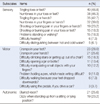2. Kirsner RS, Ma F, Fleming LE, Federman DG, Trapido E, Duncan R, et al. Earlier stage at diagnosis and improved survival among Medicare HMO patients with breast cancer. J Womens Health (Larchmt). 2010; 19:1619–1624.

3. Sasane M, Tencer T, French A, Maro T, Beusterien KM. Patient-reported outcomes in chemotherapy-induced peripheral neuropathy: a review. J Support Oncol. 2010; 8(6):15–21.

4. Postma TJ, Aaronson NK, Heimans JJ, Muller MJ, Hildebrand JG, Delattre JY, et al. The development of an EORTC quality of life questionnaire to assess chemotherapy-induced peripheral neuropathy: the QLQ-CIPN20. Eur J Cancer. 2005; 41:1135–1139.

5. Visovsky C, Collins M, Abbott L, Aschenbrenner J, Hart C. Putting evidence into practice: evidence-based interventions for chemotherapy-induced peripheral neuropathy. Clin J Oncol Nurs. 2007; 11(6):901–913.

6. Tofthagen C, McAllister RD, McMillan SC. Peripheral neuropathy in patients with colorectal cancer receiving oxaliplatin. Clin J Oncol Nurs. 2011; 15(2):182–188.

7. Ocean AJ, Vahdat LT. Chemotherapy-induced peripheral neuropathy: pathogenesis and emerging therapies. Support Care Cancer. 2004; 12:619–662.

9. Shimozuma K, Ohashi Y, Takeuchi A, Aranishi T, Morita S, Kuroi K, et al. Taxane-induced peripheral neuropathy and health-related quality of life in postoperative breast cancer patients undergoing adjuvant chemotherapy: N-SAS BC 02, a randomized clinical trial. Support Care Cancer. 2012; 20(12):3355–3364.

10. Wampler MA, Hamolsky D, Hamel K, Melisko M, Topp KS. Case report: painful peripheral neuropathy following treatment with docetaxel for breast cancer. Clin J Oncol Nurs. 2005; 9(2):189–193.

11. Richardson PG, Briemberg H, Jagannath S, Wen PY, Barlogie B, Berenson J, et al. Frequency, characteristics, and reversibility of peripheral neuropathy during treatment of advanced multiple myeloma with bortezomib. J Clin Oncol. 2006; 24(19):3113–3120.

12. Kim JH, Choi KS, Kim TW, Hong YS. Quality of life in colorectal cancer patients with chemotherapy-induced peripheral neuropathy. J Korean Oncol Nurs. 2011; 11(3):254–262.

13. Clark PG, Cortese-Jimenez G, Cohen E. Effects of reiki, yoga, or meditation on the physical and psychological symptoms of chemotherapy-induced peripheral neuropathy: a randomized pilot study. J Evid Based Complementary Altern Med. 2012; 17(3):161–171.

14. Cavaletti G, Cornblath DR, Merkies ISJ, Postma TJ, Rossi E, Frigeni B, et al. The chemotherapy-induced peripheral neuropathy outcome measures standardization study: from consensus to the first validity and reliability findings. Ann Oncol. 2013; 24(2):454–462.

15. Kim HY, Kang JH, Yoon HJ, Jung SH, So HS, Kim SR. Reliability and validity of the Korean version of the EORTC quality of life questionnaire to assess chemotherapy-induced peripheral neuropathy: the QLQ-CIPN20. In : Poster session presented at the meetings of the 4th Global Breast Cancer Conference; 2013 Oct 10-12; Seoul, Korea.
16. Faul F, Erdfelder E, Buchner A, Lang AG. Statistical power analyses using G*Power 3.1: tests for correlation and regression analyses. Behav Res Methods. 2009; 41:1149–1160.

17. Fayers PM, Aaronson NK, Bjordal K, Groenvold M, Curran D, Bottomley A, et al. The EORTC QLQ-C30 scoring manual. 3rd ed. Brussels: European Organization for Research and Treatment of Cancer;2001.
18. Yun YH, Park YS, Lee ES, Bang SM, Heo DS, Park SY. Validation of the Korean version of the EORTC QLQ-C30. Qual Life Res. 2004; 13:863–868.

19. Yun YH, Bae SH, Kang IO, Shin KH, Lee R, Kwon SI, et al. Cross-cultural application of the Korean version of the European Organization for Research and Treatment of Cancer (EORTC) Breast Cancer Specific Quality of Life Questionnaire (EORTC QLQ-BR23). Support Care Cancer. 2004; 12(6):441–445.
20. Kwak MK, Kim EJ, Lee ER, Kwon IG, Hwan MS. Characteristics and quality of life in patients with chemotherapy-induced peripheral neuropathy. J Korean Oncol Nurs. 2010; 10(2):231–239.

22. Merli F, Bertini M, Luminari S, Mozzana R, Berte R, Trottini M, et al. Quality of life assessment in elderly patients with aggressive non-Hodgkin's lymphoma treated with anthracycline-containing regimens. Haematologica. 2004; 89(8):973–978.
23. Kautio A, Haanpaa M, Kautianinen H, Kalso E, Saarto T. Burden of chemotherapy-induced neuropathy: a cross-sectional study. Support Care Cancer. 2011; 19:1991–1996.

24. Wolf SL, Barton DL, Qin R, Wos EJ, Sloan JA, Liu H, et al. The relationship between numbness, tingling, and shooting/burning pain in patients with chemotherapy-induced peripheral neuropathy (CIPN) as measured by the EORTC QLQ-CIPN instrument, N06CA. Support Care Cancer. 2012; 20:625–632.

25. Tofthagen C, Overcash J, Kip K. Falls in persons with chemotherapy-induced peripheral neuropathy. Support Care Cancer. 2012; 20:583–589.







 PDF
PDF ePub
ePub Citation
Citation Print
Print





 XML Download
XML Download